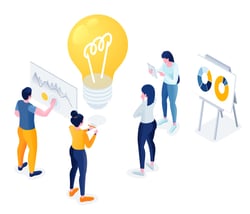 Designing physical products is a thrilling experience, from sharing the initial concept with your team to watching the product take shape during manufacturing and finally having a positive impact on the customer's everyday life. Making physical products is also a lengthy and detailed process. Product managers must collaborate with market experts, engineers, designers, manufacturers, and many more stakeholders to see the product successfully through the launch. Physical product creation relies on experts, materials, technology, and artistry to come to life. Here’s what you should know about physical product development.
Designing physical products is a thrilling experience, from sharing the initial concept with your team to watching the product take shape during manufacturing and finally having a positive impact on the customer's everyday life. Making physical products is also a lengthy and detailed process. Product managers must collaborate with market experts, engineers, designers, manufacturers, and many more stakeholders to see the product successfully through the launch. Physical product creation relies on experts, materials, technology, and artistry to come to life. Here’s what you should know about physical product development.
What Is Product Development?
Product development is the detailed process of creating and making products. Some products are physical-only, while others are digital, and others incorporate both physical hardware and digital software. Products that integrate hardware and software are often referred to as cyber-physical products. This article focuses on the challenges and processes involved with the physical product development.
Understanding the Physical Product Development Lifecycle
 Physical products have a development lifecycle involving stages from idea and concept to product and beyond. The complexity of a product and the development methodology will determine the length of the development lifecycle and the order in which these stages fall. For example, product testing happens regularly throughout development with agile or hybrid approaches. With complex physical product development, the main testing and validation period tends to happen after the prototype is complete.
Physical products have a development lifecycle involving stages from idea and concept to product and beyond. The complexity of a product and the development methodology will determine the length of the development lifecycle and the order in which these stages fall. For example, product testing happens regularly throughout development with agile or hybrid approaches. With complex physical product development, the main testing and validation period tends to happen after the prototype is complete.
Let’s briefly look at each development stage and what is involved before exploring the nuances of physical product development.
Stage #1: The Idea
All great products start as an idea. Whether they come from an individual or a team, the idea is the beginning point. Needs and gaps in the market, technological advancements, or creative vision can drive new ideas. Product managers should share visions for physical products with the product stakeholders before moving on to the concept generation stage.
Stage #2: Concept Generation
Once an idea is selected, it doesn’t automatically launch into production. The idea moves into the concept development stage. During this time, product managers will research the feasibility of the idea and conduct market analysis. They’ll also work with their product teams to create an initial concept design. A clear product roadmap and plan will help communicate to stakeholders and funders why this idea is worth supporting.
Stage #3: Design & Engineering
The next stage involves expanding on the product concept in greater detail. The product design gets finalized, and detailed engineering plans are created. The level at which the product teams will prototype, test, and refine the product design before getting started will depend on whether they follow traditional stage-gate methodology or agile methodology principles.
In the stage-gate approach, product plans are highly detailed, and a detailed business case must be approved before a complete prototype is built and tested. With the agile approach, there is more flexibility to build, test, and refine the product repeatedly to ensure the best version is ready for launch, with less detailed prep at the start.
In either scenario, it’s essential to design the product development strategy and set clearly defined goals that are shareable with everyone involved to avoid missing the mark.
Stage #4: Prototypes & MVPs
Companies using the stage-gate process will develop a complete product prototype to test and validate the concept. Creating a prototype can take some time, depending on the scale and complexity of the design. Still, it does allow for rigorous testing before launching the product into full-scale production.
When following agile methodology or a hybrid approach, the focus should be on creating a minimum viable product rather than a complete prototype. An MVP allows a company to create a basic product version to test and gather feedback on to improve and perfect sooner in the development process. It also allows companies to launch and sell the MVP version to generate revenue while the next iteration is in development.
Stage #5: Manufacturing Starts
The product manufacturing stage begins once the product receives approval at the prototype stage or the MVP is ready for mass production. At this point, the product is manufactured at scale according to the finalized designs and the product plan. Quality control measures should be implemented throughout this process to maintain consistency and address any problems as early as possible.
Stage #6: Product Testing Happens
As mentioned earlier, testing and validating the product are vital activities that ensure the product is developed as per the plan and functions properly. Testing may happen throughout the process and after the prototype is complete.
Physical products take time to build and test; therefore, you want to ensure the finished version is the best possible model. Failing to test a physical product or its components adequately can result in high risks once the product launches. If customers are unhappy with the product or vital functions don't operate properly, a company can experience significant financial losses.
Stage #7: The Product Launches to the Market
Launching a physical product to the market requires planning and multiple teams working together to make the launch successful. Your sales team must line up vendors who will carry and sell your product. They might also work with an online sales team if your product will be available to order online. From there, you’ll need distribution plans to ensure your product reaches the right destination and the customer.
In tandem with launching and distribution, your marketing team will create strategies to promote your product to the right market. Marketing should start before the official launch to generate excitement for the product and continue after the product reaches the market.
Idea Generation and Conceptualization of Physical Products
 Having a new idea may feel great, but if you have yet to analyze the market demand or test the feasibility of the concept, the thought may be less exciting than it initially sounds. Not all ideas lead to successful products. When investing the capital and time that physical products require, ensuring the idea is good is vital. With software, developers can fix solutions and release them to the customer after a product is sold. This is not the case with physical products. Updates and fixes can only happen with future product models, which is why it's so important to get it right the first time.
Having a new idea may feel great, but if you have yet to analyze the market demand or test the feasibility of the concept, the thought may be less exciting than it initially sounds. Not all ideas lead to successful products. When investing the capital and time that physical products require, ensuring the idea is good is vital. With software, developers can fix solutions and release them to the customer after a product is sold. This is not the case with physical products. Updates and fixes can only happen with future product models, which is why it's so important to get it right the first time.
What Is a Feasibility Study?
Conducting a feasibility study for a product idea allows a company to complete a comprehensive risk assessment associated with developing a new physical product, including evaluations for technical, economic, legal, operational, and financial risks.
A feasibility study also provides a cost-benefit analysis for the product idea. By estimating the costs and potential benefits, a feasibility study reveals insights into the product's financial viability, helping executives make informed decisions. In addition to the financial component, a feasibility study enables product managers to determine resource allocation. Will the required resources, such as capital, technology, human resources, and time, be available for the successful development of the product? If not, what changes can be made to the plans to make it a viable choice?
Accessing Necessary Information
Product management teams' biggest challenge with idea management is accessing the information they need to complete their feasibility studies. The company may have detailed customer feedback and user demand research, but do the product managers have ready access to the information? Using accessible software to connect product stakeholders is an effective way to ensure that all teams have access to necessary information.
Prioritizing the Right Ideas
Ideas are not difficult to generate, but choosing the right ones can be difficult. Because of the time involved and the resources invested in creating physical products, it’s crucial for product managers to have an established strategy in place to manage ideas and prioritize the best options. Product managers will need to back up their decisions to sell their plans to the executives or the main decision-makers for the product.
Designing Physical Products
 When designing a physical product, designers and engineers must work together to ensure the product is functional and desirable. How a product looks is important, but the degree to which the aesthetics of the product matter to the customer will depend on the market. When a product looks great but doesn't function or is challenging to operate, the customer will be disappointed. On the other hand, if the product works well but has a terrible design, it will also hamper sales.
When designing a physical product, designers and engineers must work together to ensure the product is functional and desirable. How a product looks is important, but the degree to which the aesthetics of the product matter to the customer will depend on the market. When a product looks great but doesn't function or is challenging to operate, the customer will be disappointed. On the other hand, if the product works well but has a terrible design, it will also hamper sales.
One company that has mastered function, ergonomics, and aesthetics is Dyson. From their vacuums to air treatment devices to headphones, Dyson is known for sleek designs, powerful functions, and innovative technology. Their products come with an expected high-end price point because customers know and trust they are purchasing value, performance, and a sleek product.
Material Selection
Component and material procurement for physical products is a significant department in physical product management. Once the designers and engineers have created the plan for the product, the right materials need to be sourced. Several factors product teams must consider include the following:
- Selection of materials
- Availability of materials
- Durability
- Cost
- Environmental impact
Prototyping and Refined Development:
 The final design of a product relies on the rigorous process of prototyping methods. Traditionally, physical products required a physical prototype to test and validate, which took time and resources to create. With the advancements of modern technology, prototypes can now be generated in less time using 3D printing techniques, CNC machining, and even digital rendering.
The final design of a product relies on the rigorous process of prototyping methods. Traditionally, physical products required a physical prototype to test and validate, which took time and resources to create. With the advancements of modern technology, prototypes can now be generated in less time using 3D printing techniques, CNC machining, and even digital rendering.
Accurate prototyping enables companies to see how the finished product looks, feels, and operates. It also gives product teams the chance to test the product internally and with customer focus groups. Having the chance to refine and fix problems before manufacturing on a large scale can save a company large sums of money.
Manufacturing and Quality Assurance
Manufacturing is the most important difference between physical product development and digital product development because it requires the conversion of raw materials, components, or parts into the finished product. This completed product must meet the customer’s expectations and the product plan’s specifications.
Fabrication, assembly, and packaging are all important processes in manufacturing. Each part must be made according to the specs to assemble the finished product properly. From there, correctly assembling all the parts is essential for the finished product to function and look the way the customer expects it to. And the packaging of the product also matters. Depending on the product, sometimes the packaging design is just as important to selling and marketing the product inside.
Types of Manufacturing
There are different types of manufacturing a company may select to create their products. The first type is Job Shop, where a product is customized to the customer’s requests or created in small-batch production. The next type is Batch Production, which is suited to larger companies that can afford to manufacture a larger quantity of products to distribute and sell. The third type is Mass Production, which is the large-scale production of standardized goods. Companies that establish themselves in a market will take advantage of the cost-savings of mass production.
Quality Assurance
Another step that is vital for physical product development is ensuring that a product or service meets specific requirements and standards. This process is called Quality Assurance (QA). It focuses on preventing defects and errors rather than detecting them after production. In order to test for quality, you must first establish quality goals and standards, as well as procedures for achieving those results, before manufacturing begins.
Some of the key components of QA are quality planning, quality control, and continuous improvement.
Quality Planning: This happens before manufacturing begins and involves setting quality goals, standards, and procedures.
Quality Control: This happens at all stages of manufacturing and involves monitoring and inspecting the production process to identify and correct problems.
Continuous Improvement: Throughout the manufacturing process, your QA team should be analyzing data and feedback to make ongoing recommendations to improve the manufacturing process.
Market Launch and Distribution Strategies:
 Launching and marketing physical products are far more involved than digital products because of the distribution and delivery of the product. While digital products can launch immediately as long as the customer has an internet connection, physical products take time to deliver.
Launching and marketing physical products are far more involved than digital products because of the distribution and delivery of the product. While digital products can launch immediately as long as the customer has an internet connection, physical products take time to deliver.
Sales and distribution teams must collaborate to determine which vendors will have which quantity of the product based on projected demands in that market. Careful research, accurate projections, and continuous feedback are essential to mapping out the distribution strategy.
Successful Product Launches
Launching a product successfully on the market largely relies on nailing the right market. While manufacturers will have established the target market before creating the product, it's also important for the marketing team to have clarity on who they are marketing to. Even if your company creates an outstanding product, if the marketing doesn't speak to the target audience, the sales will not meet your expectations.
Marketing teams also need to know how to talk about the product in the marketing material. Clearly communicating the problem the product solves for the customer is a vital pillar in successful marketing. Encouraging teams to cross-collaborate in preparation for the product launch will keep everyone aligned with the product vision.
Create a Product Launch Checklist or Roadmap
Marketing teams should have their own product launch roadmaps and checklists to ensure that all steps required to promote the product are achieved. The more launches a company has, the more likely they are to have developed a process they replicate each time to foster success.
Post-Launch: Consumer Feedback and Product Iteration
 Even after the product launches, the lifecycle does not end there. Product teams must continue to gather customer feedback and integrate the useful points into their product refinement plans. Knowing how to improve the product for the next launch or next iteration is how major brands grow their market share.
Even after the product launches, the lifecycle does not end there. Product teams must continue to gather customer feedback and integrate the useful points into their product refinement plans. Knowing how to improve the product for the next launch or next iteration is how major brands grow their market share.
How to Create Success in Physical Product Development
The product development life cycle works best when product development teams follow detailed plans and procedures, communicate effectively, and use product roadmaps to keep everything on track. Success can be found by following proven strategies throughout the product development process, including idea generation, concept creation, design and engineering, prototyping, manufacturing, product testing, and product launching.
Creating and launching physical products can be challenging, whether you’re establishing a new product or have done this many times, but the experience can be very rewarding. Creating physical goods that solve real-world problems for customers and receiving positive feedback in the form of reviews, testimonials, or sales is a great feeling for product teams. Keep creating and checking back to the Gocious blog for more helpful advice and strategies on product development.
Additional Resources for Anyone Interested in Designing Physical Products or the World of Physical Product Management
- What Is the Difference Between Product Roadmaps for Physical vs. Digital Products
- 5 Factors Separating the Product Management of Hardware vs. Software Products
- The Impact of Increased Software on Hardware Product Management
- The High Stakes of Physical Product Development Compared to Digital Products & How to Manage Risk
- Webinar Replay: Tools for Modern Product Management
- Free E-Book: A New Approach to Roadmapping


